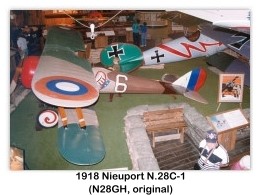
| ||||
|---|---|---|---|---|
 |
 |
 |
 |
 |



























| ||||
|---|---|---|---|---|
 |
 |
 |
 |
 |


























Nieuport N.28C-1
French WWI single-engine single-seat biplane fighter
Archive Photos 1,2
Nieuport N.28C-1 on display (c.1993) at the San Diego Aerospace Museum, San Diego, CA (Photos by John Shupek)


Nieuport N.28C-1 on display (5/4/1995) at the National Museum of the United States Air Force, Wright Patterson AFB, Dayton, Ohio (Photos by John Shupek)

Nieuport N.28C-1 on display (2/16/2004) at the National Air and Space Museum Steven F. Udvar-Hazy Center, Chantilly, Virginia (Photo by Jim Hough, 2/16/2004)

Overview 3
The Nieuport 28 (N.28C-1) was a French biplane fighter aircraft flown during World War I, built by Nieuport and designed by Gustave Delage. Its principal claim to fame is that it was the first aircraft to see service with an American fighter squadron. By the middle of 1917 it was obvious that the Nieuport 17 was unable to cope with the latest German fighters, and that direct developments of the 17, such as the Nieuport 24bis. were unable to offer a substantially improved performance. In fact, the Nieuport was already being rapidly replaced in French service with the SPAD S.VII.
The Nieuport 28 design was an attempt to adapt the concept of the lightly built, highly maneuverable rotary engine fighter typified by the Nieuport 17 to the more demanding conditions of the times. It had a more powerful engine, and a new wing structure, for the first time a Nieuport biplane was fitted with conventional two spar wings, top and bottom, in place of the sesquiplane V-strut layout of earlier Nieuport types. Ailerons were fitted to the lower wings only. The tail unit’s design closely followed that of the Nieuport 27, but the fuselage was much slimmer, in fact it was so narrow that the machine guns had to be offset to the left. The prototype (and, perhaps a handful of early production aircraft) had marked dihedral in the top wing only and a tightly spaced cabane structure. Production machines had only a slight dihedral in the upper wing, taller cabane struts, and two Vickers machine guns.
Operational History 3
By early 1918, when the first production Nieuport 28s became available, the type was already surplus from the French point of view. The SPAD S.XIII was a superior aircraft in most respects, and was in any case firmly established as the standard French fighter.
On the other hand, the United States Army Air Service was desperately short of fighters to equip its projected Pursuit (fighter) squadrons. The SPAD was initially unavailable due to a shortage of Hispano-Suiza engines, and the Nieuport was offered to, and perforce accepted by, the American Expeditionary Force (AEF), as an interim alternative. A total of 297 Nieuport 28’s were purchased by the Americans, and they were used to equip the very first American fighter squadrons, starting in March 1918. All together, four AEF Pursuit squadrons flew Nieuport 28s operationally, the 27th, 94th, 95th and 103rd Aero Squadrons.
Due to an early shortage of machine guns in the American squadrons some early patrols were flown with one machine gun. On 14 April 1918, the second armed patrol of an AEF fighter unit resulted in two victories when Lieutenants Alan Winslow and Douglas Campbell (the first American-trained ace) of the 94th Aero Squadron each downed an enemy aircraft. Several well known World War I American fighter pilots, including Quentin Roosevelt, the son of United States President Theodore Roosevelt, as well as American aces like the 26-victory ace, Captain Eddie RickenBacker, began their operational careers on the Nieuport 28.
On the whole the type was not a success, however. Although very maneuverable and easy to fly, its performance turned out to be mediocre and its engine unreliable. More seriously, the mixed plywood/fabric skinning of the wings proved problematic, the fabric which covered the rear portion of the wings tending to balloon and become detached from the plywood leading section. Although a solution to this problem was speedily found, the operational Nieuports in American service were replaced with SPADs as soon as sufficient of the latter became available. This process was complete by the end of July 1918.
After the end of the war some examples of the type crossed the Atlantic with the returning American forces with a small number supplied to various foreign air forces. Switzerland obtained 15 Nieuport 28s and Greece received a small number of aircraft.
Operators 3
Nieuport 28 Specifications and Performance Data 3
General Characteristics
Performance
Armament
References 3